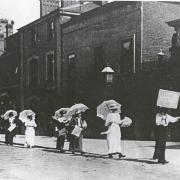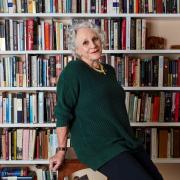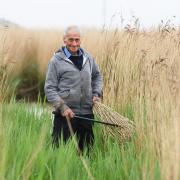It was a spectacle Colin Ballard would never forget. The Great War, though it had yet to acquire that title, was barely 20 days old and the commanding officer of the first unit of the Norfolk Regiment to fight on European soil for more than half a century found himself at the forefront of a global struggle which would eclipse every conflict that had gone before.

From rising ground near the Belgian village of Elouges, the 46-year-old veteran of colonial wars waged on the veldt and parched wildernesses of Britain’s African empire saw the massed ranks of the German army marching towards him.
They were moving in “dense columns” over open ground. “We could see at least four or five thousand and knew that there must be many others out of sight,” wrote Ballard.
He was unclear about the final tally, but later asserted: “I saw more Germans in that one first than I ever set eyes on during the rest of the war.” In fact, there were two entire enemy divisions and at least six artillery batteries arrayed against two infantry battalions, a couple of batteries and the scattered remnants of a cavalry brigade forming the rearguard of the retreating British Expeditionary Force.
A few minutes later, the thunder of the German guns signalled the start of the onslaught. The Norfolk Regiment’s “war to end all war” had begun in earnest.

By the end of that hot August afternoon 100 years ago, Colin Ballard’s men had earned the regiment’s first battle honour of the conflict at the cost of almost 260 casualties.
Elouges marked the beginning of a terrible blood sacrifice spanning four years and a host of grim battlefields stretching from the pitted wastes of France and Flanders to the shores of Gallipoli and the dusty plains of Mesopotamia and Palestine. The regiment’s final death toll among its active service battalions would amount to 5,576 men, a little under a sixth of all those who wore the Britannia cap badge during the course of the war.
They were part of an unparalleled expansion of the county’s affiliated infantry regiment that would eventually swell to 12 battalions and a grand total of 32,375 men, encompassing regulars, part-time territorials, so-called Kitchener volunteers and conscripts.
The transformation of a small professional military force into a vast “citizens’ army”, comprising enthusiastic but untrained recruits who abandoned their jobs in factories, on farms and in offices in a spasm of patriotic fervour, began within weeks of the outbreak of war.

In a little over a month, three “service” battalions of volunteers - the 7th, 8th and 9th - were formed, although it would be some time before they were ready for action and several months before they even had sufficient rifles and uniforms to go round.
While the territorials continued to train and guard against an invasion that never came, it was left to the regulars to shoulder the initial burden of a war that some optimists had assumed would be over by Christmas.
As the remains of Colin Ballard’s 1st Battalion exchanged yuletide pleasantries with their enemies in no-man’s-land in a rare but temporary cessation of hostilities, their comrades in the 2nd Norfolks were acclimatising to a very different kind of campaigning. Landed near Basra in November 1914 as part of a small expeditionary force despatched to Mesopotamia to safeguard Britain’s oil interests against Germany’s new ally, Turkey, they found themselves waging war in a land redolent with echoes of the Old Testament but where only the discomfort and disorganisation was of biblical proportions.
Writing from Kurna, near the “so-called Garden of Eden”, a Norfolk officer saw only miles of wilderness “destitute of all crops”. “I see in the papers,” he noted, “they talk about ‘this fertile delta’ - by Jove, one can’t see it - only hope it is better than it looks.” Sadly, it was not. Mesopotamia, once the cradle of civilisation, turned into a living hell for all too many of the Norfolks. Spurred on by a succession of easy victories, the promise of a rapid advance into Baghdad proved a mirage that dissolved into defeat, retreat and humiliating surrender. Part of a force besieged in Kut, they were starved into submission and a cruel captivity that fewer than a third of the Norfolks survived.
It was neither the first nor last time the regiment would pay a heavy price for their commanders’ under-estimation of Ottoman resolution. A little over eight months earlier, in August 1915, the territorials of the 4th and 5th Battalions endured a baptism of fire at Suvla Bay on the Gallipoli peninsula. In a single day’s fighting remembered now chiefly for the involvement of men recruited from the Royal Sandringham estate, around 150 men advanced too far, were cut-off and all but wiped out, though their actual fate was not known until the end of the war. It was an object lesson in muddle and mismanagement that cost the lives of 18 of the “King’s men”.
Among those who died were brothers Edward Randall and Victor Cubitt of Honing Hall. A third brother, Eustace, survived only to fall victim to an even more disastrous attack mounted by the same two battalions nearly two years later during the Second Battle of Gaza. Though largely forgotten today, the ill-starred assault on the Turkish positions guarding the gateway to the Holy Land dealt a devastating blow to the Norfolk Regiment. Total casualties exceeded 1,100 and the 208 men killed from the 5th Battalion was the regiment’s highest single loss of the war, surpassing anything sustained during the darkest days on the Western Front.
For years after, April 19, or Gaza Day as it was known throughout Norfolk, was a signal for remembrance every bit as poignant as Armistice Day.
The defeats at Gallipoli, Kut and Gaza, however, proved only temporary setbacks which would be avenged by reconstructed Norfolk battalions which ultimately marched to victory both in Mesopotamia and Palestine. It was a similar story in Belgium and France. Bruising experiences during the retreat from Mons and the Loos offensive together with costly attacks on the Somme were part and parcel of a steep learning curve that ultimately led to final victory in November 1918.
From the first day on the Somme in July 1916, when the 8th Norfolks, a Kitchener battalion made up mainly of volunteers, scored one of the British army’s few successes, to Cambrai in November 1917, where the 9th Norfolks avenged bloody repulses in successive September offensives, the regiment played a full part in the struggles which wore down and eventually overwhelmed the German army.
Triumph, however, came at a heavy price. During the last nine months of the war, the 1st, 7th and 9th battalions together suffered more than 2,800 casualties. Among the dead was Paston old boy and 1914 volunteer Terry “TAK” Cubitt. A veteran of the fighting on the Somme and at Cambrai, he was also an enthusiastic writer whose jottings in the trenches include a poem titled An Unknown Grave.
The last verse stands as a fitting epitaph not only for those numberless Norfolk soldiers known only “Unto God” but also for the camaraderie that helped men endure so much slaughter and suffering:
I do not know his name, nor yet his number,
I do not know the town from which he came;
But he’s done his bit for England, and all that England means;
And England won’t forget him, though he doesn’t know his name.
Time to remember
The Royal Norfolk Regimental Museum in Norwich is staging a series of events and special exhibitions over the coming months.
Letters Home, the first of a number of temporary displays, opens in the Norwich Castle Rotunda for a 10-month run on September 8, featuring personal correspondence and diaries much of which has never previously been publicly exhibited. The treasure trove of papers, drawn from the regimental museum’s archives, will provide a moving insight into the human cost of war and its impact on Norfolk soldiers and their families.
Military family history workshops will be staged on the second Wednesday of each month from September (1.30-4pm) in the Norwich Castle Study Centre at the Shirehall. Staff will be on hand to guide researchers through the museum’s collection, including war diaries, personal letters and the regimental casualty book.
Later in the year, the Castle will host a day of activities inspired by the 1914 Christmas truce in which soldiers of the Norfolk Regiment took part. The programme on November 29 (10.30am-4pm) will feature choral performances, talks, a giant commemorative art project and a family history trail.
Meanwhile, staff at the museum will be charting the regiment’s war through a series of objects which will appear in a monthly blog, to be launched on August 4 - the 100th anniversary of Britain’s entry into the war - and continuinge throughout the four years of centenary commemorations on http://www.norfolkinworldwar1.org/
Further information, booking details, ticket prices and times, on 01603 493625.
Don’t miss the special First World War centenary editions of our sister magazine Let’s Talk this August, September and October which feature memorable and moving stories about Norfolk people who fought in the conflict. August issue is out now, priced £1.75.



























